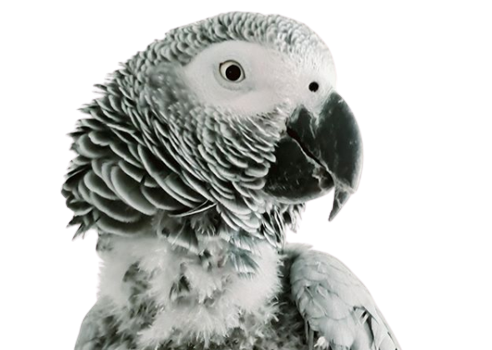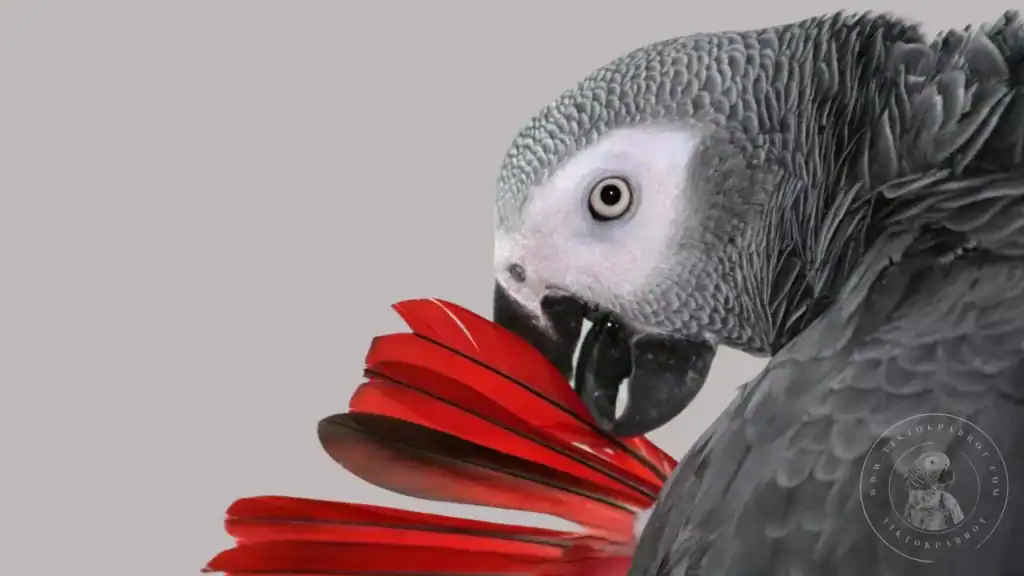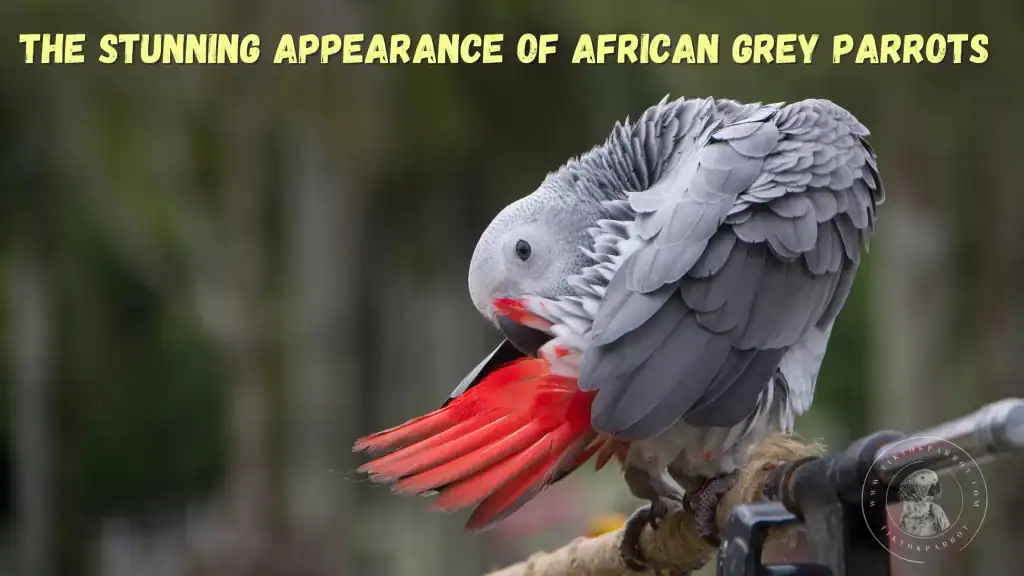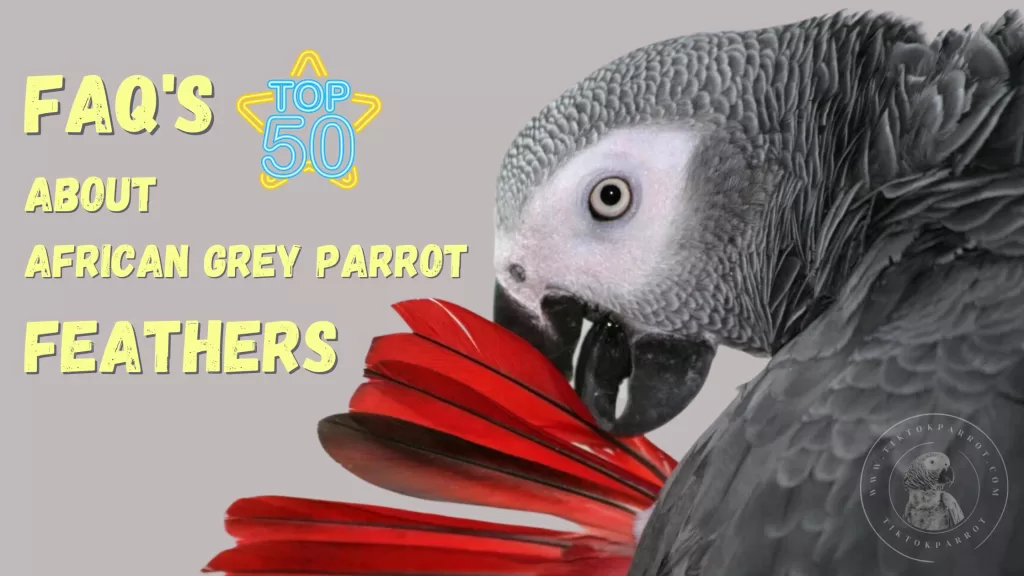African grey parrots are known for their intelligence, personality, and beauty. They are popular among pet owners and bird enthusiasts. These intelligent creatures are known for their impressive cognitive abilities and their ability to mimic human speech.
But, did you know that African grey parrots are also known for their mesmerizing feathers? These striking feathers are a visual delight for bird lovers all over the world. In this post we’ll explore the mesmerizing feathers of African greys and why they are such a visual delight for bird enthusiasts.
African Grey Parrots are known for their striking feathers. This article delves into the mesmerizing feathers of African grey parrots and why they are a visual delight for bird lovers.
The feather of African greys is a true visual symphony, inviting bird lovers to marvel at their captivating beauty. With an enchanting array of grey hues, from charcoal to silver, these intelligent birds flaunt their unique scalloping patterns, evoking a sense of awe and wonder.
Their striking red tails provide a vivid contrast, further elevating their allure. To top it off, a subtle iridescence graces their plumage, adding an ethereal touch of shimmering magic. These breathtaking feathers not only demonstrate nature’s artistic mastery but also serve as a testament to the African greys adaptability and resilience in the wild.
The Stunning Appearance Of African Grey Parrots
Nature has graced us with some of the most exquisite creatures, and the African grey parrot is no exception. Known for its intelligence, this stunning bird is a marvel to behold, especially for bird enthusiasts. Now let’s take a closer look at the mesmerizing plumage of these parrots and explore why they’ve captured the hearts of bird lovers around the world.
The Iconic Grey Feathers
The mesmerizing grey feathers of African grey parrots give these birds a dignified and elegant appearance. Their feathers range from light to dark grey, with a beautiful shine that catches the light, making them a visual delight for bird lovers.
A Symphony of Shades
The feathers of these brilliant birds are nothing short of breathtaking. At first glance, you may think they are simply grey, but upon closer examination, you’ll discover a symphony of shades.
From charcoal and slate to silver and ash, the intricacies of their plumage are truly a sight to behold. These varying hues come together to create a stunning visual tapestry that distinguishes them from other parrot species.
A Cloak of Red
While their grey feathers are undoubtedly captivating, there’s another element that makes these birds a visual delight – their striking red tails. This burst of vibrant color stands out in contrast to their otherwise muted tones, making it a focal point of their overall appearance.
As the birds mature, the red becomes even more pronounced, deepening into a rich and fiery hue. This vivid contrast sets them apart from other parrots and adds to their overall allure.
A striking contrast to their grey plumage, the African grey parrot’s bright red tail adds a splash of color to their appearance. The vivid red tail is a distinguishing feature of the Congo African Grey, while the Timneh African Grey has a darker, maroon-colored tail.
A Fusion of Texture
The texture of these parrots’ feathers is just as fascinating as their coloration. In addition to the smooth, velvety plumage covering most of their bodies, they also possess a unique scalloping pattern on their necks and backs.
This delicate lace-like appearance adds a layer of complexity to their visual charm and makes them all the more enchanting.
The Iridescent Touch
As if the various shades of grey and the contrasting red tail weren’t enough, the feathers of these intelligent birds also boast a subtle iridescence.
When the light catches their plumage at just the right angle, you’ll be treated to a subtle shimmer of metallic sheen. This effect, though subtle, adds a touch of magic and mystique to their already captivating appearance.
A Symbol of Beauty
The stunning feathers of these parrots aren’t just for show – they also serve a purpose in the wild. Their unique coloration helps them blend into their natural environment, camouflaging them from potential predators.
This perfect balance of form and function only adds to the admiration bird enthusiasts have for these incredible creatures.
My Final Thoughts
The mesmerizing feathers of the African grey parrot are undoubtedly a visual delight for bird lovers. From the intricate shades of grey to the vibrant red tails, these birds are a testament to the beauty and diversity of the natural world.
So, the next time you find yourself in the presence of one of these magnificent birds, take a moment to appreciate the true artistry and splendor of their exquisite plumage. Now you can read below the top 50 questions mostly asked about African grey’s feathers.
FAQs about African Grey Parrot Feathers
- How Do African Grey Parrots Use Their Feathers?
African grey parrots use their feathers for a variety of reasons. One of the most important uses is for communication. When an African Grey is feeling threatened or excited, it will puff up its feathers to appear larger and more intimidating. This is a warning to potential predators or rivals to stay away. - What Makes African Grey Parrot Feathers So Mesmerizing?
African Grey parrots have a unique combination of feather colors that make them truly mesmerizing. Their feathers are mostly grey, but they also have accents of white and black. The feathers on their heads are a darker shade of grey, while the feathers on their necks and wings are a lighter shade. When the light hits their feathers just right, they give off a stunning shimmer. - How Can You Appreciate The Mesmerizing Feathers Of African Grey Parrots?
There are many ways to appreciate the beauty of African grey parrot feathers. If you are lucky enough to own an African grey, take some time to admire its feathers up close. You can also observe grey parrots in the wild or at a bird sanctuary. Seeing these birds in their natural habitat can be a truly awe-inspiring experience. - Do African Grey Parrots Shed Their Feathers?
Like all birds, African grey parrots shed their feathers regularly. This process is called molting. Molting allows the bird to replace old, damaged feathers with new ones. African grey parrots typically molt once or twice a year, and the process can take several weeks. - What Makes African Grey Parrots’ Feathers Different From Other Birds?
While all birds have unique feathers, African grey parrots’ feathers are particularly striking. Their combination of grey, white, and black makes them stand out from other parrot species. Additionally, their feathers are very soft and velvety, which adds to their mesmerizing appearance. - What is the unique color pattern of African Grey Parrot feathers?
African grey feathers showcase a beautiful blend of light to dark grey shades, with striking red tail feathers that make them stand out in the avian world. - What colors can be found on an African Grey Parrot’s feathers?
The grey parrot primarily features various shades of grey, ranging from charcoal to silver. Additionally, these birds have vibrant red tails that provide a striking contrast to their grey plumage. - How can I identify the sex of an African Grey Parrot based on their feathers?
It is difficult to differentiate between male and female African grey parrots based on their feathers alone, as both sexes have similar coloration. DNA testing or expert evaluation is recommended for accurate sex determination. - What purpose do the red tail feathers of African Grey Parrots serve?
The red tail feathers of African grey parrots serve as an eye-catching feature, playing a role in communication and mating displays. - How often do African Grey Parrots molt their feathers?
African greys typically molt once or twice a year, shedding old feathers and growing new ones to maintain optimal plumage health. - Can the health of an African Grey Parrot be determined by examining their feathers?
Yes, the condition of an African grey parrot’s feathers can provide insight into their overall health. Dull, damaged, or irregularly growing feathers may indicate underlying health issues. - What should I do if my African Grey Parrot starts plucking its feathers?
Feather plucking in African greys may be caused by stress, poor diet, or health issues. Consult an avian veterinarian to determine the cause and appropriate treatment. - How can I maintain the vibrant color of my African Grey Parrot’s feathers?
Providing a balanced diet rich in essential nutrients, access to natural sunlight or UVB lighting, and regular bathing will help maintain the vibrant color and condition of your grey parrot’s feathers. - Are African Grey Parrot feathers waterproof?
Yes, African grey parrots have a preen gland that secretes oil, which they spread over their feathers to keep them waterproof and well-conditioned. - How does the feather structure of African Grey Parrots contribute to their remarkable flight abilities?
Grey parrots have strong, lightweight feathers with an intricate structure that enables agile flight, precise maneuverability, and efficient energy usage during long-distance travel. - Can African Grey Parrots change the color of their feathers?
African greys cannot change the color of their feathers. Their distinct grey and red coloration remains consistent throughout their lives, barring any health or environmental factors that may affect feather quality. - Do African Grey Parrots have any unique patterns on their feathers?
Yes, these parrots have a delicate scalloping pattern on their necks and backs. This lace-like appearance adds complexity and charm to their visual appeal. - Does the African Grey Parrot’s plumage change as they age?
As these birds mature, the red coloration of their tails becomes more pronounced, deepening into a rich and fiery hue. - Is it normal for my African Grey Parrot to lose a few feathers daily?
Yes, it is normal for African grey parrots to lose a few feathers daily as part of their natural feather growth and replacement process. - Is there any iridescence in African Grey Parrot feathers?
Yes, their feathers possess a subtle iridescence, which becomes visible when the light hits their plumage at the right angle, producing a shimmering metallic sheen. - What are pin feathers, and how do they develop in African Grey Parrots?
Pin feathers are new, developing feathers that grow in to replace molted feathers. They appear as small, dark, cylindrical structures that eventually mature into fully-grown feathers in African greys. - How can I safely remove a broken feather from my African Grey Parrot?
Removing a broken feather from an African grey should be done with care to avoid injury. Consult an avian veterinarian for guidance or assistance in removing the feather safely. - Can African Grey Parrot feathers be used for any practical or artistic purposes?
Yes, Grey parrot feathers can be used for various purposes, such as jewelry making, dreamcatchers, and other art projects. However, it is essential to ensure that the feathers are not taken from the bird for these purposes and they are naturally fallen or broken from the bird. - Are there any legal restrictions on owning or selling African Grey Parrot feathers?
Yes, there may be legal restrictions on owning, selling, or trading African grey parrot feathers, as they are a protected species under CITES (the Convention on International Trade in Endangered Species). Always check local laws and regulations before acquiring or using their feathers for any purpose. - What is the average length of an African Grey Parrot’s feather?
The length of African grey feathers varies, with their longest tail feathers reaching up to 8 inches (20 cm) and their wing feathers ranging from 4 to 6 inches (10-15 cm). - How can I clean my African Grey Parrot’s feathers without causing damage?
To clean your grey parrot’s feathers, offer them a shallow dish of lukewarm water for bathing or gently mist them with a spray bottle. Avoid using any harsh chemicals or detergents that may damage their delicate feathers. - What is the function of the contour feathers in African Grey Parrots?
Contour feathers in African greys are the external feathers that give the bird its streamlined shape, aiding in flight and providing insulation and protection against the elements. - Can the age of an African Grey Parrot be determined by its feathers?
Determining the exact age of an African grey through their feathers can be challenging. However, younger birds may have a slightly darker plumage and a less-defined scalloped pattern on their feathers compared to older birds. - What role do African Grey Parrot feathers play in communication and body language?
African grey parrot feathers play a vital role in communication and body language, as they can convey emotions, intentions, and physical well-being through various feather postures and displays. - What are the semiplumes in African Grey Parrots, and what is their function?
Semiplumes are soft, fluffy feathers found beneath the contour feathers in grey parrots. They provide insulation, help maintain body temperature, and contribute to the bird’s aerodynamics during flight. - How do African Grey Parrots preen their feathers?
African grey parrots preen their feathers by using their beak to carefully groom and align each feather, spreading the preen gland’s oil over the surface to keep them clean, waterproof, and in optimal condition. - What should I do if my African Grey Parrot’s feathers become discolored?
Discolored feathers in grey parrots may indicate health issues, poor diet, or environmental factors. Consult an avian veterinarian for a proper assessment and treatment plan. - Do African Grey Parrots experience a juvenile molt?
Yes, African grey parrots experience a juvenile molt, which typically occurs when they are around 6-12 months old. During this time, they shed their baby feathers and grow in their adult plumage. - Are there any unique features in the wing feathers of African Grey Parrots?
The wing feathers of African greys have a specialized structure that allows them to produce minimal noise during flight, enabling them to fly silently and efficiently. - How can I help my African Grey Parrot during the molting process?
To support your grey parrot during molting, provide a balanced diet rich in protein and vitamins, offer regular bathing opportunities, and ensure a low-stress environment for optimal feather growth. - Can African Grey Parrot feathers cause allergies in humans?
While it is uncommon, some individuals may be allergic to African grey feathers or the dander they produce. Proper hygiene and regular cleaning of your bird’s environment can help minimize allergens. - What are the filoplumes in African Grey Parrots, and what is their function?
Filoplumes are hair-like feathers found near the base of contour feathers in African grey parrots. They have sensory functions, allowing the bird to detect changes in feather position and airflow during flight, which helps maintain optimal aerodynamics. - Can environmental factors affect the quality of African Grey Parrot feathers?
Yes, environmental factors such as humidity, temperature, air quality, and exposure to natural sunlight can impact the health and appearance of grey parrot feathers. Ensure your bird’s living conditions are suitable for maintaining healthy plumage. - Do African Grey Parrots experience feather iridescence?
African grey parrots do not exhibit iridescence in their feathers like some other bird species. Their distinct grey and red coloration remains consistent throughout their lives, without any iridescent qualities. - Can I use commercial feather conditioners on my African Grey Parrot?
While some commercial feather conditioners may be safe for use on grey parrots, it is essential to consult your avian veterinarian for recommendations and ensure the product is specifically designed for parrots to avoid potential harm. - How do African Grey Parrot feathers aid in thermoregulation?
African grey parrot feathers help with thermoregulation by trapping a layer of air close to their skin, which insulates the bird and helps maintain body temperature. They can also adjust their feather position to allow for heat dissipation or retention, depending on environmental conditions. - Can African Grey Parrots regrow damaged feathers?
Yes, African greys can regrow damaged feathers during their regular molting cycles. However, if the damage is extensive or caused by an underlying health issue, it may take longer for the feathers to grow back or they may not return to their original condition. Consult an avian veterinarian for proper assessment and treatment. - Do African Grey Parrot Feathers Have Any Special Properties?
African grey parrot feathers have been used in traditional medicine for their alleged healing properties. Some people believe that the feathers can help with various ailments, such as arthritis and migraines. However, there is no scientific evidence to support these claims. - What is the purpose of the African Grey Parrot’s unique coloration?
The parrots’ distinctive coloration serves as a natural camouflage in their environment, helping them blend in and stay hidden from potential predators. - What Should You Do If Your African Grey Parrot Loses a Feather?
If your African grey loses a feather, it is important to keep the area clean and dry. You can use a clean, damp cloth to gently clean the area around the feather. Do not try to remove the feather yourself, as this can cause pain and discomfort for your bird. If you notice any signs of infection or inflammation, contact your veterinarian immediately. - Can You Collect and Display African Grey Parrot Feathers?
It is illegal to collect and display grey parrot feathers without a permit. These birds are protected by law, and it is illegal to harm or kill them. If you find a feather on the ground, you can keep it as a souvenir, but you cannot sell or trade it. - Do African Grey Parrots undergo molting, and how does it affect their feathers?
Yes, African greys undergo molting, a natural process in which they shed old feathers and grow new ones. Molting usually occurs once a year and can last several weeks. During this time, their feathers may appear less vibrant, but they regain their full splendor once the molt is complete. - Are there any color variations or mutations in African Grey Parrots’ feathers?
While most grey parrots display the classic grey plumage with a red tail, there are rare color mutations, such as the “red factor” African Grey, which exhibits an increased presence of red feathers across its body. However, these color mutations are uncommon and typically result from selective breeding in captivity. - Can the quality of an African Grey Parrot’s feathers indicate its health?
Absolutely, the condition of a parrot’s feathers can be an indicator of its overall health. Healthy African greys have smooth, well-groomed feathers, while dull, ragged, or unkempt feathers may suggest poor nutrition, stress, or illness. Regularly monitoring your parrot’s plumage can help you spot potential health issues early. - How can I maintain my African Grey Parrot’s feather health?
To keep your parrot’s feathers in top condition, provide a well-balanced diet that includes pellets, fresh fruits, vegetables, and occasional nuts or seeds. Additionally, ensure your bird has access to a shallow dish of water for bathing or mist them gently with water to encourage preening and maintain feather cleanliness.
If you found this blog helpful, It would be great if you could share it with your family and friends who might find it useful as well.
You might like to read these as well
African Grey Parrot Male or Female? (Determine Gender of African Grey)
The Mesmerizing Eyes of African Grey Parrot & What They Can Tell
Understanding of Grey Parrot’s Body Language
The Battle of the Birds: African Grey Parrot vs Macaw
Is Your African Grey a Jealous Bird? Here’s What You Need to Know!
The Surprising Benefits of Owning an African Grey Parrot
African Grey Parrots: The Ultimate Guide to Care and Training
Unlock the Secrets of Choosing the Perfect African Grey Parrot
The Importance of a Cage for Your African Grey Parrot
Winning Parrot Names: How to Choose a Name That Strengthens Your Bond
For more useful content about African grey parrots, you can subscribe my site with your email to get notification upon publishing a new blog, the subscribe box you can see on the right side of this page. Also if you get an alert on your web browser while browsing my site, allow it and that will also give you an alert whenever I publish a new blog.
Stay safe and much love !






